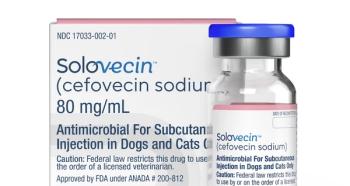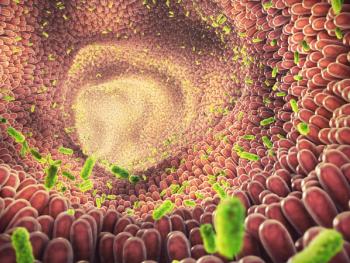
Ascending urinary tract infections can occur more commonly than recognized clinically
Signalment: Canine, Labrador Retriever, 8 weeks old, male, 17.8 lbs.
Signalment:
Canine, Labrador Retriever, 8 weeks old, male, 17.8 lbs.
Clinical history:
The puppy was vaccinated and was doing fine at that time. The puppy presented the next day for vomiting and diarrhea. The puppy was on Albon and Baytril treatment last week for coccidia (treated by the breeder).
Image 1.
Physical examination:
The findings include rectal temperature 100.2° F, heart rate 185/min, respiratory rate 20/min, pink mucous membranes, normal capillary refill time, and normal heart and lung sounds. There is a painful mass in the mid-abdomen.
Laboratory results:
A complete blood count, serum chemistry profile and urinalysis were performed and are outlined in Table 1. The fecal examination and canine parvovirus tests are negative.
Image 2.
Radiographic review:
Survey abdominal radiographs were done. The abdominal radiographs show evidence of possible ascites and gaseous distension of the gI tract. There is no obvious foreign body or any obstructive gas pattern seen.
Ultrasound examination:
Thorough abdominal ultrasonography was performed with the puppy positioned in dorsal recumbency.
My comments:
There is a small amount of free fluid accumulated within the abdominal cavity – a normal finding in this age of puppy. The liver shows a homogeneous texture in its parenchyma. Hepatic vessels are prominent. Doppler study shows normal flow velocity values. No masses noted within the liver parenchyma. The gall bladder is mildly distended, and its walls are not thickened or hyperechoic. The gall bladder does contain some sludge material. The spleen shows an inhomogeneous texture in its parenchyma - no masses noted. The left and right kidneys are similar in size, shape and echotexture. Each kidney shows an increased echogenicity in the renal cortex and a mildly to moderately dilated renal pelvis. The renal vessels are dilated in the right kidney. No masses or calculi were noted in either kidney. The urinary bladder is distended with urine and contains some urine sediment material - no masses or calculi noted. The left and right adrenal glands are similar in size and shape. The stomach, small intestine and colon are normal. The pancreas shows a homogeneous texture in its parenchyma.
Table 1: Results of laboratory tests
Case management:
In this case, most likely active pyelonephritis is present. It is likely that the existing pyelonephritis is contributing to the current azotemia. A bacterial urine culture is warranted. Fluid therapy and daily antibiotics for at least four weeks are a management approach to this case. I would probably use Clavamox BID in this puppy as the preferred antibiotic. Otherwise, supportive care for the management of renal failure is indicated. After about one month of medical therapy, one will then know the degree of residual renal disease present.
Canine pyelonephritis & case management
Natural host defenses against ascending urinary tract infection include mucosal defense barriers, ureteral peristalsis, ureterovesical flap valves and an extensive renal blood supply. Pyelonephritis usually occurs by ascension of bacteria causing lower urinary tract infection. Hematogenous seeding of the kidneys does not usually cause pyelonephritis. In addition, an upper urinary tract infection is frequently accompanied by a lower urinary tract infection.
Ascending urinary tract infections probably occur much more commonly than is recognized clinically - because many dogs with pyelonephritis are asymptomatic or have signs limited to lower urinary tract infection. Signs of pyelonephritis may be none or include polyuria/polydipsia, abdominal or lumbar pain, and/or signs associated with lower urinary tract infection - dysuria, pollakiuria, stranguria, hematuria, and malodorous or discolored urine. The physical examination may show no abnormalities or pain on palpation of kidneys and a fever.
Image 3.
The ascending urinary tract infection may be caused by aerobic bacteria - most common bacterial isolates are Escherichia coli and Staphylococcus species and less common bacterial isolates may include Proteus, Streptococcus, Klebsiella, Enterobacter and Pseudomonas species, which frequently infect the lower urinary tract and may ascend into the upper urinary tract.
Ectopic ureters, vesicoureteral reflux, congenital renal dysplasia and lower urinary tract infection increases the risk of an ascending urinary tract infection. Medical conditions that often predispose the dog to a urinary tract infection are diabetes mellitus, hyperadrenocorticism, exogenous steroid administration, renal failure, urethral catheterization, urine retention, uroliths and urinary tract neoplasia.
Clinical diagnosis of pyelonephritis is often presumptive - based on results from CBC, serum chemistry profile, urinalysis, urine culture and imaging procedures.
A definitive diagnosis is not usually required for planning treatment. Because many dogs lack specific signs attributable to pyelonephritis, any dog with urinary tract infection could potentially have pyelonephritis. Always consider the possibility of pyelonephritis as a differential diagnosis for any dog with fever of unknown origin, polydipsia/polyuria, chronic renal failure and/or lumbar/abdominal pain.
The CBC results are often normal with chronic pyelonephritis, but leukocytosis and neutrophilia with a left shift may be detected in some dogs. The serum chemistry profile is usually normal unless chronic pyelonephritis is contributing to chronic renal failure (azotemia with an inappropriate urinary specific gravity).
Image 4.
The urinalysis may reveal hematuria, pyuria, proteinuria, bacteriuria and leukocyte casts. Leukocyte casts are diagnostic for renal inflammation and usually result from pyelonephritis. Remember that dilute urine specific gravity in dogs with nephrogenic diabetes insipidus often occur secondary to pyelonephritis and absence of abnormalities does not rule out pyelonephritis.
Dogs with chronic pyelonephritis may have a negative urine culture and require multiple urine cultures to confirm urinary tract infection. Ultrasonography and excretory urography are the preferred imaging procedures done for presumptively differentiating between upper and lower urinary tract infection.
Ultrasonographic findings supporting pyelonephritis include dilation of the renal pelvis and proximal ureter and a hyperechoic mucosal margin line within the renal pelvis and/or proximal ureter. Excretory urography may show dilation and blunting of the renal pelvis with lack of filling of the collecting diverticula and dilation of the proximal ureter. In dogs with acute pyelonephritis, the kidneys may be large; in dogs with chronic pyelonephritis, the kidneys may be small with an irregular surface contour. Concomitant nephroliths may be seen in some dogs evaluated by survey radiography, ultrasonography or excretory urography.
Image 5.
Urine cultures
Definitive diagnosis requires urine cultures obtained from the renal pelvis or parenchyma or histopathology from a renal biopsy. Pyelocentesis can be performed percutaneously using ultrasound guidance or during exploratory surgery. To confirm the diagnosis, the biopsy specimen should include the renal cortex and medulla. Recurrent pyelonephritis may be asymptomatic.
Unresolved chronic pyelonephritis may lead to chronic renal failure and diagnostic follow-up, therefore, is important to document resolution of the pyelonephritis. In dogs with nephroliths, resolution is unlikely unless the nephroliths are removed.
One should preferentially base the antibiotic selection on urine culture and sensitivity testing. Antibiotics used should achieve good serum and urine concentrations and not be nephrotoxic. High serum and urinary antibiotic concentrations do not necessarily ensure high tissue concentrations in the renal medulla; therefore, chronic pyelonephritis may be difficult to cure. Do give orally administered antibiotics at full therapeutic dosages for at least four to six weeks. Do not use aminoglycosides unless no other alternatives exist on the basis of urine culture and sensitivity testing. The trimethoprim/sulfa combinations can cause significant side effects (keratoconjunctivitis sicca, blood dyscrasias, polyarthritis) when administered for more than four weeks. Do urine cultures and urinalysis during antibiotic administration (approximately one week into treatment) and one and four weeks after antibiotics are finished.
Dogs with pyelonephritis will usually return to normal health unless the dog also has nephrolithiasis, chronic renal failure or some other underlying cause for urinary tract infection. Established infection of the renal medulla may be difficult to resolve because of poor tissue penetration of antibiotics.
Dr. Hoskins is owner of DocuTech Services. He is a diplomate of the American College of Veterinary Internal Medicine with specialities in small animal pediatrics. He can be reached at (225) 955-3252, fax: (214) 242-2200, or e-mail:
Newsletter
From exam room tips to practice management insights, get trusted veterinary news delivered straight to your inbox—subscribe to dvm360.






